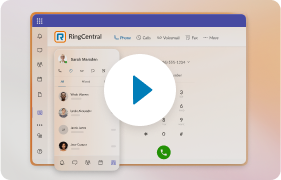These days, people can have natural conversations with their phones as if they were chatting with a friend. That’s thanks to the rapid evolution of voice recognition AI (artificial intelligence) technology.
Voice recognition AI is another breakthrough in the bid to make technology more accessible and user-friendly. It helps humans communicate with machines without the need to type. Instead, they simply make their requests through natural speech patterns, just like having a regular conversation.
The convenience and increasing accuracy of this technology have led to massive enterprise adoption. Want to learn more about how this tech is changing how we interact with computers? Keep reading.
AI voice recognition technology: Key takeaways
- Voice recognition AI is making technology more accessible by enabling natural speech interactions between humans and machines.
- It processes audio input through multiple stages, including acoustic modeling and language processing, to accurately interpret human speech.
- Voice AI didn’t used to be able to understand much beyond basic words. However, it has evolved dramatically to now handle natural conversations, multiple languages, and complex tasks.
- Some business applications of voice recognition include automation of customer service, meeting transcription, voice search optimization, CRM integration, virtual office assistance, and data analysis.
What is AI voice recognition?
AI voice recognition is a technology that identifies and verifies the unique characteristics of an individual’s voice.
Also known as speaker recognition or voice authentication, the aim of this tech is to determine the speaker’s identity. It achieves this through analysis of their vocal patterns and biometric markers.
Now, AI voice recognition is usually used interchangeably with AI speech recognition. However, while they’re technically related, they are distinct concepts.
Speech recognition, also known as automatic speech recognition (ASR), focuses on converting spoken words into a computer-readable format. It analyzes audio input, extracts the spoken words, and transforms them into text that computers can process and understand.
In simple terms, voice recognition AI is interested in who said what, while speech recognition AI tries to understand what was said.
So, speech recognition happens when you ask Siri to tell you the weather forecast for today. Voice recognition is why your phone unlocks only when it recognizes your unique voice pattern.
Throughout the rest of this post, we will use these terms interchangeably to refer to the broader area of speech and voice recognition technology.
How AI is used in speech recognition
A few decades ago, computers could barely get past the basic functions of a machine, let alone talk to a human. Today, people can ask computers for cooking instructions, to tell jokes, and more.
But what gives the computer the ability to actually understand the sounds of a person and make sense of it all? Well, this is possible, thanks to the powerful subfield of AI called speech recognition.
Below is a breakdown of everything that happens “under the hood” to make it possible:
- Audio input: The speech recognition process starts with audio input, which typically occurs through a microphone or other audio devices.
- Pre-processing: Next, the audio input undergoes pre-processing to remove background noise, improve clarity, and normalize the audio signal.
- Acoustic modeling: Afterwards, the system uses acoustic modeling techniques to analyze and interpret the audio input. It breaks down the speech into smaller units known as phonemes and maps them to corresponding linguistic representations. AI at this stage helps compensate for variations in pronunciation, accents, and speaking rates.
- Language modeling: Language modeling is another critical step in speech recognition. It uses statistical patterns and grammar rules to predict and correct potential transcription errors. They improve the accuracy and contextuality of the transcribed text.
- Decoding: The system uses a process called decoding to match the audio input against its extensive database of acoustic and language models. This enables it to determine the most likely transcription.
- Text output: Finally, the speech recognition system generates an output in written form. This is usually text that accurately represents the spoken words.
Now you know how AI in speech recognition works, let’s take a look at how the technology has developed over time.
The history of voice recognition technology
Voice recognition AI has come a long way. It’s gone from being able to only recognize a limited number of spoken words to now having proper conversations with people.
Here’s how this technology has evolved over the years.
It all started in the 1920s when Nell Labs developed a device called the “Audrey”, which could only recognize a limited number of words. However, things got a bit better in the 1950s when more advanced speech recognition systems began to spring up.
One such advanced system was IBM’s “Shoebox” machine, which could recognize 16 words and digits spoken by a single person.
In the 1960s, there was a significant breakthrough: The creation of the first continuous speech recognition systems. These systems were able to recognize speech in real-time, without needing to pause between words.
This giant stride was due to advancements in computer technology and the introduction of the hidden Markov models—a statistical technique used to model patterns in sequential data like speech.
The 1970s and 1980s saw voice recognition technology being integrated into telephone systems. This enabled the creation of voice-controlled call routing systems.
By the 1990s, speech recognition had become so advanced that it could be used for dictation and other applications, like voice-controlled personal assistants.
More sophisticated voice recognition systems were then developed in the 2000s. For example, those used in virtual assistants like Apple’s Siri and Amazon’s Alexa.
These systems were able to understand natural language and perform complex tasks, such as setting reminders and making phone calls.
In recent years, there have been even more advancements in voice AI. One such development is deep learning algorithms. This technology makes it possible for machines to understand more complex and nuanced speech.
Today, many devices have built-in voice recognition capabilities that can understand multiple languages, accents, and speaking styles with remarkable accuracy.
How to use AI voice recognition software and solutions in business
Like other AI technologies, voice recognition AI simplifies how we interact with machines. Here are some ways this technology supports businesses by saving time and boosting productivity:
Customer service automation
Customer service is one critical business area that benefits from voice recognition AI. With customers increasingly having high expectations, this technology can help meet a few of them.
One such expectation is reducing long hold times. Most customers dread contacting customer service because of it. To solve this problem, businesses turn to interactive voice response (IVR)—an automated telephone system that enables callers to access information without speaking to a live agent. Traditional IVRs were limited to detecting touch-tone keypad responses.
However, advanced systems like RingCentral’s AI-powered IVR use speech recognition and natural language processing to elevate the experience.
Rather than pressing buttons to navigate through menu options, customers can simply state their needs in everyday language—for example, “check my balance.”.
Then, the ASR system captures their speech and processes the audio to isolate their voice.
Next, it converts it to text (“Check my balance”) and passes the text to the IVR for action (retrieving their account balance).
This level of convenience not only increases customer satisfaction but also frees up customer service agents. As a result, they’re available to handle more complex inquiries that truly require human intervention.
Meeting transcription and documentation
Manually transcribing audio for meeting notes or call records is stressful and time-consuming. It also diverts valuable human resources from handling more strategic business activities.
However, by using voice recognition AI for audio and video transcription, the process becomes faster and more reliable.
AI transcription, like that which is included as part of RingCentral’s solutions, improves business communication by automatically transcribing calls, meetings, and voicemails with high accuracy.
Using NLP, RingSense AI goes beyond basic speech-to-text. It understands context, idioms, and even whispers. It also offers features like real-time transcription, automated summaries, and action item identification. This, in turn, streamlines workflows and boosts productivity.
Voice search optimization
Voice search is another business application for speech recognition AI, and it is changing how we find information online. Instead of typing into search engines, people can ask questions naturally using their voice.
According to a recent study, about 20.5 percent of people globally use voice search. That number will continue rising as the technology gets better and more people get more comfortable using voice commands.
Voice search isn’t just for search engines. Businesses can optimize their websites and platforms for voice-based queries to improve user experience and accessibility.
Sales and CRM integrations
Voice recognition AI is also revolutionizing sales processes and customer relationship management (CRM) systems. By integrating voice capabilities into CRM platforms, sales teams can update records, log calls, and manage customer interactions more efficiently.
For example, sales representatives can use voice commands to:
- Update deal status
- Schedule follow-up calls
- Add contact notes
- Create new opportunities
- Set reminders for important tasks
This hands-free approach allows sales professionals to update their CRM systems while driving between meetings or multitasking. As a result, it ensures more accurate and timely data entry.
Virtual assistants for internal operations
Many businesses are implementing voice-activated virtual assistants to streamline internal operations. Here’s how virtual assistants powered by voice recognition AI can enhance workplace efficiency:
Task management and scheduling
Virtual assistants can help employees manage their calendars, set reminders, and schedule meetings through simple voice commands. For instance, saying “schedule a team meeting for next Tuesday at 2 PM” automatically checks participants’ availability and sends out invitations.
Office environment control
Voice-activated systems can manage office environments by controlling lighting, temperature, and equipment. This hands-free control is particularly useful in settings where touching surfaces isn’t practical or hygienic.
Workflow automation
Voice-enabled assistants can automate routine tasks like:
- Sending email updates
- Generating reports
- Ordering office supplies
- Booking conference rooms
- Processing expense reports
Improved accessibility
Voice recognition technology makes workplace tools more accessible to employees with physical disabilities or those who prefer voice interaction over typing.
Data analysis and business intelligence
Voice interfaces powered by conversational AI allow executives and decision-makers to query complex business intelligence systems using natural language.
Instead of navigating complex dashboards or learning specialized query languages, managers can simply ask questions like “How did Q1 sales compare to last year?” and receive immediate insights.
This, in turn, makes data analysis more accessible and efficient for users at all technical skill levels.
Voice recognition is just the tip of the AI iceberg with RingCentral
Voice recognition AI allows us to use natural speech patterns to accomplish tasks. This makes technology more accessible and efficient than ever before.
From customer service automation to meeting transcriptions and AI assist features on live calls, voice AI is helping businesses across industries become more productive and streamlined in their operations.
As with other AI technology, speech recognition gets better as you train and use the system. This then leads to more accurate and natural interactions between humans and machines.
With RingCentral, you can leverage a full suite of intelligent communication solutions beyond voice recognition. These include AI Receptionist, sentiment analysis, AI-assisted content creation, and AI coaching insights.
Ready to make the switch? See our pricing.
Voice recognition AI FAQs
Which AI technologies are used for voice recognition?
The AI technologies used for voice recognition include natural language processing (NLP), machine learning algorithms, deep neural networks, and acoustic modeling systems.
Is there a difference between voice recognition and speech recognition?
Yes. Voice recognition and speech recognition are related, however they serve different purposes. Voice recognition identifies who is speaking based on unique vocal characteristics, while speech recognition focuses on converting spoken words into text.
How can a business benefit from voice recognition AI?
Voice recognition AI helps businesses improve efficiency and customer service through automated transcription, hands-free data entry, virtual assistants, and voice-enabled search capabilities.
Updated Jul 02, 2025














